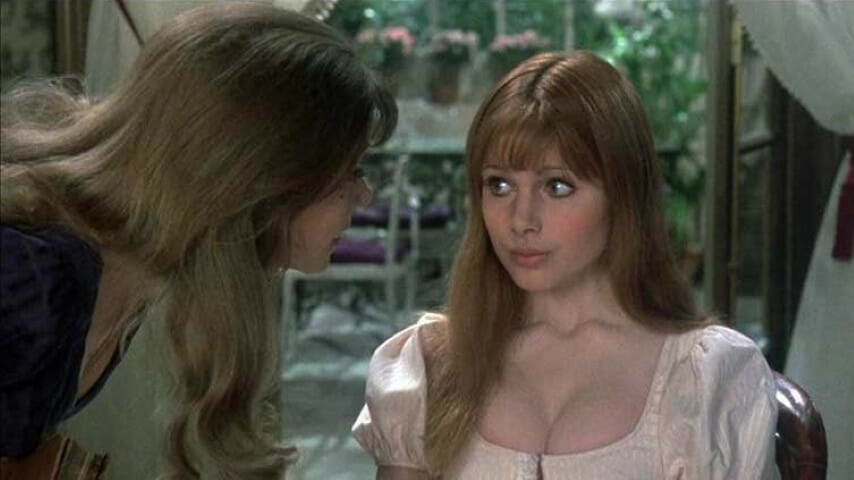
Paste’s ABCs of Horror is a 26-day project that highlights some of our favorite horror films from each letter of the alphabet. The only criteria: The films chosen can’t have been used in last year’s Century of Terror, a 100-day project to choose the best horror film of every year from 1920-2019. With some heavy hitters out of the way, which movies will we choose?
In few genres will you ever have a chance to observe social mores evolve in a more dramatic way than in the Hammer Film Productions vampire films of the 1950s-1970s. Beginning with the very successful Horror of Dracula in 1958, Hammer managed to reinvent the old Universal Monsters for a new era, chiefly through bringing old tropes to a new, EastmanColor light. Red tempera paint became a common sight, whether oozing from bite marks in the necks of damsels in distress or bursting from the chest of a staked vampire, but early entries in this Hammer series are still modest in their approach to refreshing what was already a classic archetype of horror film. They played it fairly safe, content in the belief that a bit of newfound blood (and color picture) was enough to make the genre thrilling once again.
They weren’t wrong—not in the late 1950s, anyway. But as entertainment and pop culture barreled headlong through the turbulence and pronounced societal shifts of the 1960s, it didn’t take long before even Hammer’s “new” way of doing things seemed a bit staid in comparison. The New Wave was arriving in Hollywood, and auteurs such as Herschel Gordon Lewis or George Romero were redefining shock value in films like Blood Feast or Night of the Living Dead. Producers at Hammer faced a clear impetus to push their films ever further in terms of gore and sexuality, which manifested itself with a surge in the number of deeply plunging necklines present in what were otherwise classical vampire stories like Dracula Has Risen From the Grave. This was a steady evolution throughout the 1960s, but the arrival of 1970 took Hammer’s embrace of sex to an entirely different level. This was the year of The Vampire Lovers.
Suffice to say, if you’ve only seen Horror of Dracula, it’s disconcerting to go straight to The Vampire Lovers, because it seems both familiar and utterly foreign, all at once. The moldering gothic castles, the opulent sets, the excellent period clothing and soundtracks—those all stay the same. But the violence has been ratcheted up considerably, and the newfound eroticism is unlike anything the vampire genre had seen before … especially when you consider that this is a same-sex love story.
The Vampire Lovers is one of many films based on Carmilla, an 1872 Gothic novella by Irish author Joseph Sheridan Le Fanu, and one of the foundational texts in all of vampire fiction—its publishing date predates Dracula by 26 years. It’s the story of a female vampire who preys exclusively on female victims, befriending them and ingratiating herself within their households while slowly bleeding them dry. The novel possesses unmistakeable lesbian overtones that have been made more literal in the many film adaptations—two notable ones that preceded The Vampire Lovers are 1960’s Blood and Roses and 1963’s Crypt of the Vampire. None, however, had tackled the story with such an intent to both thrill and titillate their audience, something that is made quite clear by the not-subtle tagline: “Taste the deadly passion of the BLOOD-NYMPHS!”
The film is a veritable who’s who of female Hammer stars of its day, including Ingrid Pitt, Madeline Smith and a blonde Pippa Steel, who even regular Hammer viewers might mistake as fellow Hammer beauty Veronica Carlson, who looks quite similar. The film belongs to Pitt, however, playing the sultry Carmilla as an undead fiend who seems pathologically driven to seduce literally everyone around her, be they man or woman. At the same time, however, Carmilla is surprisingly pitiable—she seems to be a pawn in a greater game we don’t fully understand, and likewise displays anguish about discovering a young woman she actually loves, rather than someone she needs to prey on for her own survival. Pitt is indisputably the villain, but an oddly sympathetic one.
The script, meanwhile, can be rather unwieldy, introducing elements it never pays off like a mysterious vampire on horseback who is always observing from a distance, seeming to will Carmilla on to commit terrible acts. His presence is never explained, or even directly addressed. Is he her vampire superior? Or the devil himself? Does anyone really care, when there’s so much exposed flesh on the screen?
And rest assured, the lesbian plot of The Vampire Lovers is not “subtext” by any means—it’s right up there on the screen, with a matter-of-factness that modern viewers may find surprising. Every turn of phrase is suggestive and sensual, even as they’re interspersed with classic scenes of gothic horror that would be at home in Hammer films from a decade earlier. That’s the odd thing about this film—it’s not just some sexploitation romp, but contains all the usual Hammer vampire beats as well. It’s the rare example of a film from this era that is legitimately trying to be BOTH scary and sexy at once, and is decently successful at each. You even get some bonus Peter Cushing—not as Van Helsing, but killing vampires nevertheless!
The Vampire Lovers was the first in what is now referred to as the “Karnstein Trilogy,” all loosely tied to Carmilla, but subsequent sequels Lust for a Vampire and Twins of Evil make less of a genuine effort at appealing as horror films, rather than sexploitation features, and they’re lesser films as a result. The relative balance displayed by The Vampire Lovers puts it in strangely unique territory, preserving its cult appeal to this very day—the consummate sexy vampire movie.
Jim Vorel is a Paste staff writer and resident horror guru. You can follow him on Twitter for more film and TV writing.